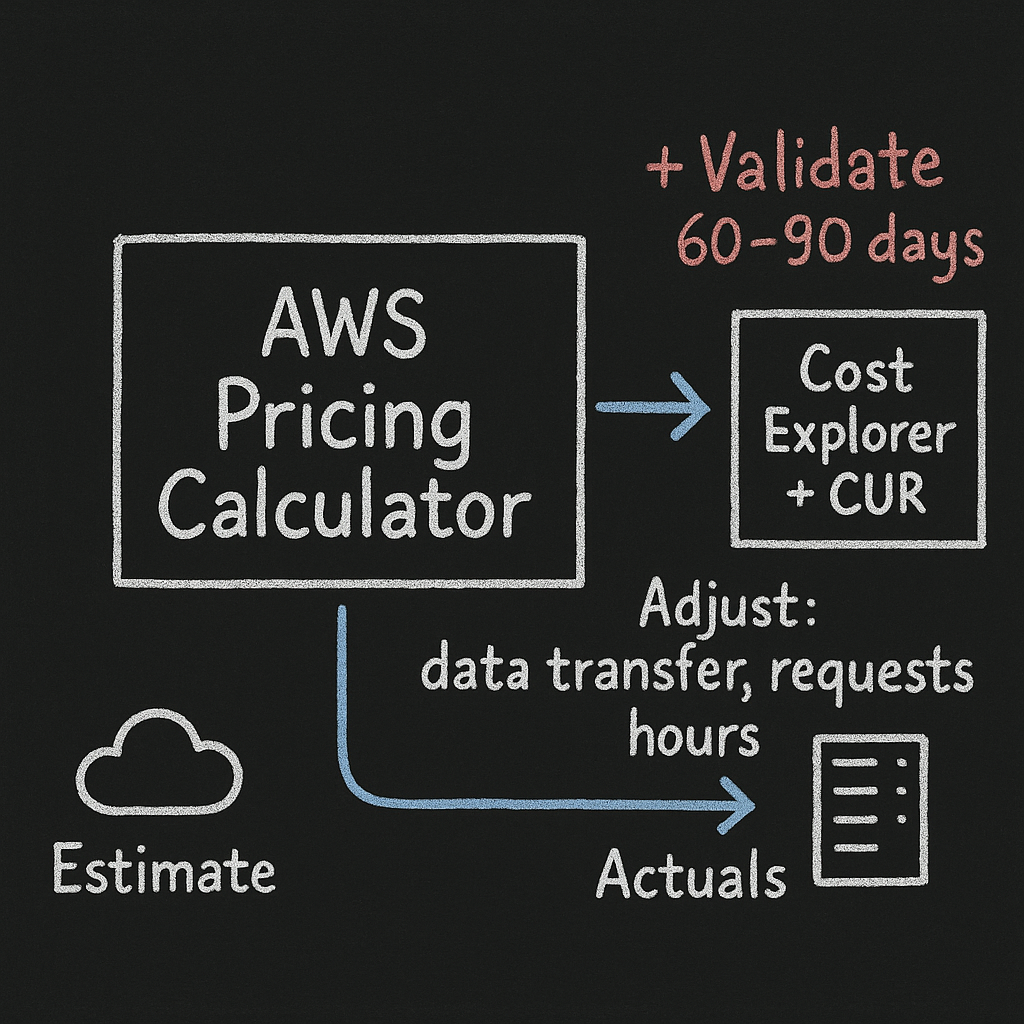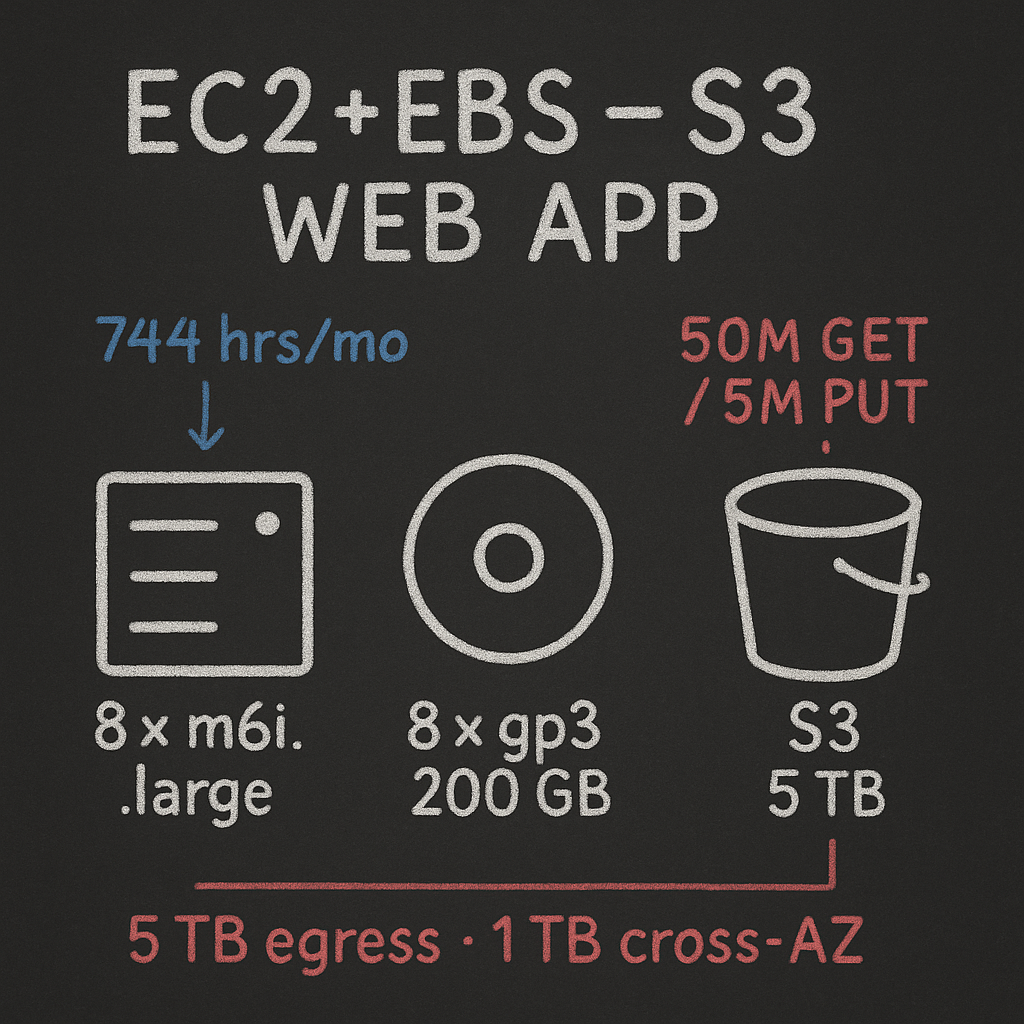AWS pricing calculator guide for cost‑aware teams
Ever opened your AWS bill and wondered where the extra 20–30% came from? If you estimate first, validate second, you can predict monthly costs with confidence—and avoid surprises.
What is the AWS Pricing Calculator?
The AWS Pricing Calculator is AWS’s official, web-based tool for estimating monthly costs before you deploy. You don’t need an AWS account to use it, and it supports over 200 major services including EC2, EBS, S3, RDS, Lambda, and EKS across all regions. Estimates can be grouped, shared via URL, and exported to CSV or PDF.

The calculator lives at AWS Pricing Calculator and provides detailed documentation in the AWS Pricing Calculator user guide.
How it compares to other AWS cost tools
Different AWS cost tools serve distinct purposes in your financial planning workflow:
AWS Pricing Calculator: Prospective estimates. Input-driven “what-if” modeling for future workloads and architecture choices. Great for pre-deployment and planning.
AWS Cost Explorer: Historical analysis. Understand past and current spend, trends, and anomalies drawn from actual billing data. Useful for validation and forecasting from real usage.
AWS TCO Calculator: On‑prem vs. AWS comparison. Models total cost of ownership when migrating from data centers to AWS. It’s not intended for detailed, service-level monthly estimates.
The key difference is that Pricing Calculator is forward-looking and requires manual inputs, while Cost Explorer analyzes what you’ve already spent.
Step-by-step: build accurate estimates that match reality
Before you start
List your assumptions up front. Good estimates come from concrete numbers:
- Regions and AZ layout (single vs. multi-AZ; single vs. multi-region)
- Expected hours of utilization per month (steady 24/7 vs. business-hours only vs. spiky)
- Data transfer patterns (intra-AZ, cross-AZ, inter-region, internet egress)
- Storage profile (GB, IOPS/throughput, snapshot behavior, lifecycle)
- Traffic profile (requests/sec, batch windows, concurrency)
Tip: If you’re exploring EC2-heavy scenarios, spin up a quick baseline in the ec2 aws calculator to sanity-check instance costs.
EC2 + EBS: a practical workflow
-
Add EC2 in the calculator
- Choose Region and Operating system
- Select Instance type (start with your target vCPU/RAM and family)
- Set Monthly hours. 744 ≈ 24/7. If you shut down non-prod nights/weekends, model fewer hours (for example, 168 for one-day-per-weekend workloads)
- Add Storage. Pick EBS gp3 for general purpose; set GB and provisioned IOPS/throughput as needed
- Networking. Explicitly add data transfer out to the internet and, if applicable, cross-AZ and inter-region traffic. The calculator requires you to enter GB/month—don’t skip this step
-
Model purchase options and coverage
- Compare On-Demand vs. Savings Plans or Reserved Instances. Use the payment option dropdown to see 1- or 3‑year commitments and upfront choices
- For spiky fleets, consider partial coverage: model a baseline under Savings Plans and leave peaks On-Demand
- If you rely on burstable T-series, remember CPU credits can change effective performance/cost; model with an appropriate baseline or consider M/C families for steady-state loads
-
Add support and extras
- Include an AWS Support plan if applicable; support is incremental to usage charges. You can add this under additional costs in the estimate
-
Export and share
- Use Export to get CSV/PDF or share the estimate URL. The calculator supports grouped estimates for multi-stack or multi-region scenarios
EBS tuning matters to cost
Right-size volumes and performance settings. Overprovisioned IOPS and throughput on io1/io2 can quietly overspend. Our detailed guide covers cost/perf tradeoffs and gp3 best practices: optimized ebs volume sizing and performance tuning aws.
S3: storage class, requests, and data transfer
- Storage: Enter GB per storage class (Standard, Standard‑IA, Glacier tiers). Consider lifecycle transitions—for example, move objects to IA after 30 days
- Requests: Add PUT/GET/Lifecycle requests. These are easy to miss but can materially impact cost at scale
- Data transfer: Include egress to the internet and inter-region replication as needed
Lambda: requests and GB‑seconds
Enter Number of invocations, Average duration (ms), and Memory (MB). The calculator converts to GB‑seconds for cost, which is essential for accurate Lambda pricing.
Multi-region and data transfer modeling
- Create separate groups per region to keep estimates clean
- Manually include inter-region and cross‑AZ transfer (the calculator won’t infer it). Underestimating these lines is a common driver of variance
How accurate is the AWS Pricing Calculator?
The calculator is as accurate as your inputs. It does not ingest your billing data, apply historical volume patterns, or automatically include third‑party marketplace fees or taxes. Industry experience shows input-only estimates often land within a broad band; the most common reason for misses is data transfer and request costs you didn’t model explicitly.
Common pitfalls to avoid
- Forgetting data transfer: Cross‑AZ and inter‑region GB are not zero; enter them explicitly
- Skipping S3 requests: PUT/GET/Lifecycle requests add up at scale (£0.005/1k requests)
- Mis-modeling burstable EC2: CPU credits can mask steady utilization; choose instance families to match actual load
- Understating Lambda duration: Enter realistic averages; don’t assume 100 ms if you’re seeing 300–600 ms in dev
- Assuming marketplace and third‑party costs are included: They are not
- Taxes/support: The calculator shows prices exclusive of taxes and adds support only if you configure it. For UK businesses, remember to add 20% VAT to estimates
Validation: turn “what‑ifs” into reliable forecasts
To get forecast-grade accuracy, validate your calculator estimate against real usage trends:
- Build the estimate in the Pricing Calculator
- Pull 60–90 days of historical costs in Cost Explorer and the Cost & Usage Report (CUR)
- Cost Explorer: Use the GetCostAndUsage API for daily unblended cost by service/region
- CUR: Compare the calculator’s EC2/EBS/S3 line items to CUR fields like
line_item_usage_amount,line_item_blended_rate, andline_item_unblended_cost
- Reconcile differences. If you’re off by >10% for a major service, check transfer, requests, and storage performance settings first
- Iterate purchase options (Savings Plans/RIs) to match your actual steady baseline; leave peaks On‑Demand or model Spot where appropriate
How Hykell complements the AWS Pricing Calculator
The calculator is perfect for planning—but it doesn’t know your reality. Hykell closes that gap by ingesting your CUR and Cost Explorer data, validating each estimate, and auto‑correcting with your actual 90-day usage patterns. We also simulate Savings Plans coverage and rightsizing so you see the “estimate vs. actual” spread before you commit.
Our workflow:
- Import your calculator estimate
- Hykell ingests your CUR and usage via the Cost Explorer API
- We run an “Estimate vs. Actual” reconciliation and flag 20%+ variances
- Our automation proposes concrete changes: rightsize EC2/EBS, tune storage classes and lifecycle, optimize Kubernetes nodes, and plan Savings Plans coverage. Many customers achieve up to 40% savings on AWS on autopilot with hykell
Helpful Hykell resources:
- Fast EC2 sanity checks: ec2 calculator
- Tactical playbooks: aws cost management best practices
- Deep-dive storage tuning: amazon ebs best practices
- Enterprise commitments: amazon aws edp
- Cross-cloud cost context: compare aws gcp prices
Real-world example: EC2 + EBS + S3 web app
- Baseline: 8 m6i.large in us-east-1, 744 hours/month

- Storage: 8x gp3 volumes, 200 GB each, modest IOPS
- S3: 5 TB Standard, transition to Standard‑IA after 30 days; 50M GET, 5M PUT per month
- Data transfer: 5 TB egress to internet; 1 TB cross‑AZ for HA
- Purchase option: 1‑year Compute Savings Plans covering 6 of 8 instances; 2 left On‑Demand for weekend peaks
In the calculator:
- Add EC2 and EBS as separate line items per instance pattern and region
- Add S3 with lifecycle and requests
- Add Data transfer lines for internet egress and cross‑AZ
- Compare On‑Demand vs. Savings Plans impact in the payment option dropdown
- Export CSV and reconcile with Cost Explorer’s past 90 days for these services/regions
FAQ: quick answers for cost-aware teams
How much does AWS cost per month? It depends entirely on services, regions, hours, data transfer, and purchase options. Use the AWS Pricing Calculator to model your stack and then validate against your last 90 days in Cost Explorer for a reliable forecast.
How do I predict AWS costs? Start with the calculator for a prospective model, then reconcile with Cost Explorer and the CUR for historical baseline. Consider Savings Plans for steady compute, lifecycle for S3, and explicit data transfer entries.
What’s the difference between the Pricing Calculator and TCO calculator? Pricing Calculator estimates monthly AWS service costs. The TCO calculator compares on‑prem vs. AWS for migrations.
Is AWS Pricing Calculator free? Yes—AWS provides it at no charge at calculator.aws.
What’s the difference between the Pricing Calculator and Cost Explorer? Calculator is forward-looking and input-driven; Cost Explorer analyzes your actual historical spend. Use both for estimates you can trust.
How do I find my current cost in AWS? Open Cost Explorer in the Billing & Cost Management console or use the GetCostAndUsage API for programmatic access.
Is the AWS pricing calculator accurate? It’s accurate for the inputs you provide. Omitting data transfer, request volumes, or realistic hours creates variance. A UK fintech startup discovered a 37% underestimation in cross-AZ traffic costs by not properly modeling peak-hour data transfer. Validate against your CUR and adjust accordingly.
Your next step
If you’re estimating, you’re already ahead. To make those estimates stick, run them through a reality check. Bring us your calculator URL and last 90 days of spend—we’ll reconcile projections with actuals, model Savings Plans coverage, and automate rightsizing. Start with our ec2 billing calculator, then put the rest on autopilot with hykell.
